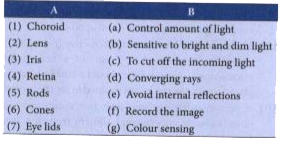Which part of the human eye is not transparent in nature?
Sclera
Cornea
Eye lens
Pupil
The correct Answer is:A
To answer the question "Which part of the human eye is not transparent in nature?", we can follow these steps:
Step 1: Identify the Parts of the Human Eye
The human eye consists of several parts, including the sclera, cornea, iris, pupil, and lens.
Step 2: Determine the Characteristics of Each Part
- Sclera: This is the white outer layer of the eyeball. It is opaque and not transparent.
- Cornea: This is the front part of the eye and is transparent, allowing light to enter.
- Iris: This is the colored part of the eye that surrounds the pupil; it is also not transparent.
- Pupil: This is the opening in the center of the iris and is not a solid structure, so it is considered transparent.
- Lens: The lens of the eye is transparent and helps to focus light onto the retina.
Step 3: Identify the Non-Transparent Part
From the analysis, we can conclude that the sclera is the part of the human eye that is not transparent. It makes up more than 80% of the surface area of the eyeball and is white in color.
Conclusion
The part of the human eye that is not transparent in nature is the sclera.
---
The human eye consists of several parts, including the sclera, cornea, iris, pupil, and lens.
- Sclera: This is the white outer layer of the eyeball. It is opaque and not transparent.
- Cornea: This is the front part of the eye and is transparent, allowing light to enter.
- Iris: This is the colored part of the eye that surrounds the pupil; it is also not transparent.
- Pupil: This is the opening in the center of the iris and is not a solid structure, so it is considered transparent.
- Lens: The lens of the eye is transparent and helps to focus light onto the retina.
From the analysis, we can conclude that the sclera is the part of the human eye that is not transparent. It makes up more than 80% of the surface area of the eyeball and is white in color.
The part of the human eye that is not transparent in nature is the sclera.
Topper's Solved these Questions
- LIGHTBOOK - PEARSON IIT JEE FOUNDATIONCHAPTER - LIGHTEXERCISE - CLASSROOM CORNER (C. Long Answer Type Questions )
15 Videos
- KINEMATICS BOOK - PEARSON IIT JEE FOUNDATIONCHAPTER - KINEMATICS EXERCISE - CONCEPT APPLICATION (Level 3) (Application Based Questions )
5 Videos
- MAGNETISM BOOK - PEARSON IIT JEE FOUNDATIONCHAPTER - MAGNETISM EXERCISE - CONCEPT APPLICATION (Level 3)
4 Videos
Similar Questions
Knowledge Check
Which part of the donor's eye is transplanted in eye donation ?
ALensBCorneaCWhole EyeDRetinaWhich part of the human eye behave similar to diaphragm of a camera ?
AIrisBRetinaCCorneaDLensOn which part of a humange eye, image of an object is formed?
AIrisBEye ballCRetinaDCornea
Which part of human eye is most sensitive to bright light?
View SolutionMatch the parts of the human eye with its function .

View SolutionOn which part of a humange eye, image of an object is formed ?
View SolutionCornea is a transparent part of
View SolutionWhich of the following parts of the human eye comprises of densely packed cones ?
View Solution
